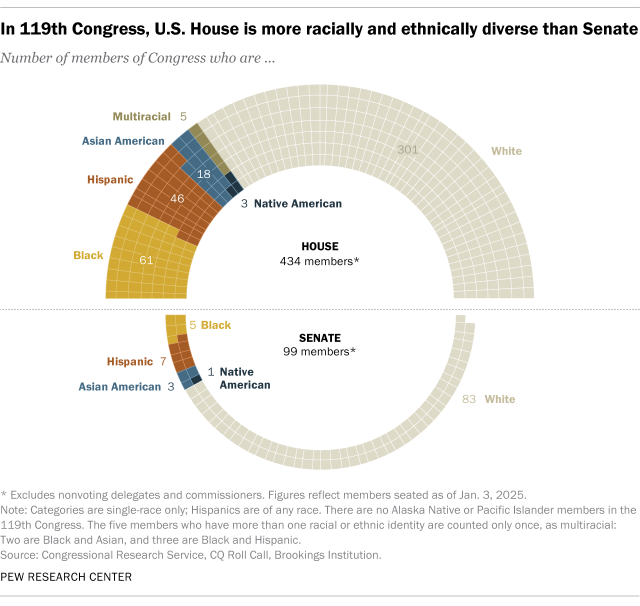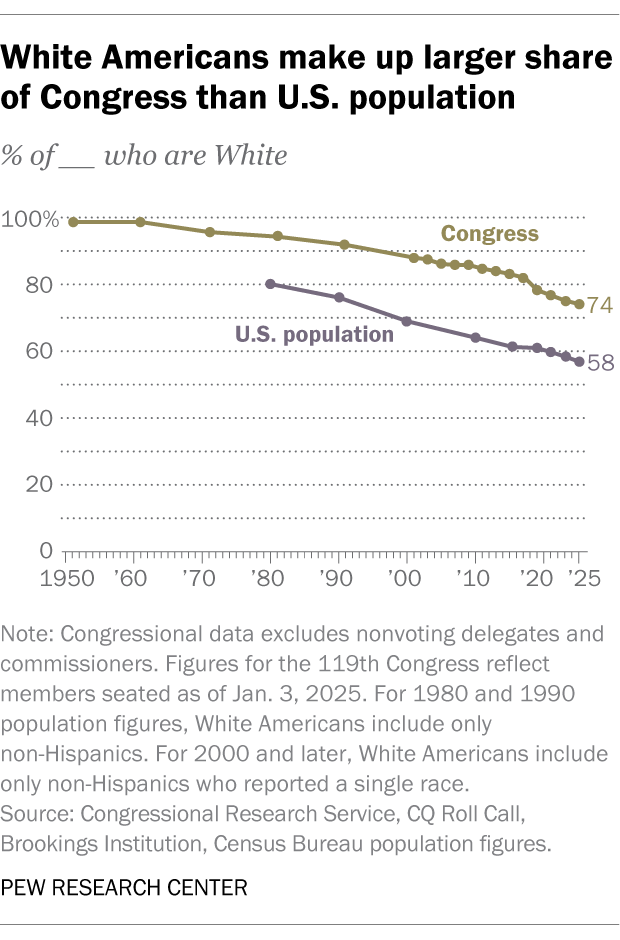Just over a quarter (26%) of voting members in the U.S. Congress identify as a race or ethnicity other than non-Hispanic White, making the 119th Congress the most racially and ethnically diverse to date. In continuation of a long-running trend, this is the eighth Congress to break the record set by the one before it.
This analysis builds on earlier Pew Research Center work to analyze the racial and ethnic makeup of the U.S. Congress. To determine the number of racial and ethnic minority lawmakers in the 119th Congress, we used data from the Congressional Research Service (CRS) and CQ Roll Call, along with news reports and lawmakers’ published biographies.
U.S. population data comes from the U.S. Census Bureau. The Census Bureau’s own research shows that it has long undercounted Black, Latino and some other population groups, which could mean they are underrepresented in the demographic statistics in this post.
Historical data was pulled from CRS, CQ Roll Call and the Brookings Institution. All racial groups refer to single-race non-Hispanics. Hispanics are of any race. Multiracial lawmakers are counted in each racial and ethnic group they identify with, but once in the overall total. Our count of Hispanic lawmakers excludes at least three members of Congress who identify as Portuguese American.
In this analysis, “newly elected” lawmakers include all members of Congress who did not serve in the 118th Congress. This group includes two House members who are serving nonconsecutive sessions in the chamber and excludes members of the House elected to the Senate.
Our analysis reflects the 533 voting members of Congress seated as of Jan. 3, 2025, the first day of the new Congress. It does not include the Florida House seat vacated by former Rep. Matt Gaetz or the Senate seat former West Virginia Gov. Jim Justice assumed Jan. 14.
Independent members of Congress are counted with the party they caucus with.
Overall, 139 of today’s senators and representatives identify as Black, Hispanic, Asian American or Native American, according to a Pew Research Center analysis of data from CQ Roll Call and the Congressional Research Service. This number has nearly doubled in the two decades since the 109th Congress of 2005-07, which had 73 members belonging to racial or ethnic minorities.
This analysis reflects the 533 voting members of the 119th Congress as of Jan. 3, 2025, the first day of the new Congress. Our count of Hispanic lawmakers excludes at least three members of Congress who identify as Portuguese American.
The vast majority (84%) of racial and ethnic minority members in the new Congress are Democrats, while 16% are Republicans. This gap is slightly wider than in the previous Congress, when 80% of non-White lawmakers were Democrats and 20% were Republicans.

The House of Representatives
In all, 28% of House members are Black, Hispanic, Asian or Native American, the same as in the previous Congress. No current voting members are Alaska Native, Native Hawaiian or Pacific Islander.
The 119th House includes five multiracial representatives – all Democrats. These five are counted in each racial or ethnic group they identify with, but once in our overall total:
In the new House, 85% of minority representatives are Democrats while 15% are Republicans. In the chamber overall, the partisan split is about 50-50.
The House also includes 16 newly elected members – including 15 Democrats and one Republican – who are racial or ethnic minorities. This is a decrease from the last Congress, when 27 newly elected members – 19 Democrats and eight Republicans – were racial or ethnic minorities.
In addition to voting members of the House, there are six nonvoting delegates who represent U.S. territories and the District of Columbia. Among these nonvoting delegates, two are Black, two are Asian/Pacific Islander, one is Hispanic and one identifies as both Hispanic and Asian/Pacific Islander.
The Senate
In the upper chamber of Congress, 16 senators are racial or ethnic minorities, an increase from 12 in the 118th Congress. Seven senators are Hispanic, five are Black, three are Asian and one is Native American.
Two Black women will serve simultaneously in the Senate for the first time in history: Democrats Angela Alsobrooks of Maryland and Lisa Blunt Rochester of Delaware are the first Black senators to represent their respective states in the chamber.
Three-quarters of the senators who are racial or ethnic minorities (12 of 16) are Democrats. The other four are Republicans:
Congress remains far less racially, ethnically diverse than U.S. as a whole

Despite growing racial and ethnic diversity on Capitol Hill, non-Hispanic White people make up a larger share of Congress than of the overall U.S. population (74% vs. 58%). This gap is about as wide as it was in 1981, when 94% of congressional lawmakers were White, compared with 80% of the U.S. population.
In the House, representation of some racial and ethnic groups is now on par with their share of the total U.S. population, while others continue to lag. For example, 14% of House members are Black, the same as the total share of Black Americans. And Native Americans and Alaska Natives now make up about 1% of both the House and the U.S. population. (The U.S. Census Bureau counts Native Americans and Alaska Natives together in its population data, but there are currently no Alaska Natives serving in Congress.)
On the other hand, the share of Hispanic representatives in Congress is much lower than the Hispanic share of the U.S. population (11% vs. 20%). Asian Americans, meanwhile, account for 4% of House members and 6% of the national population.

